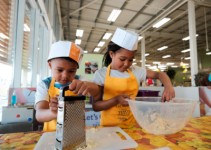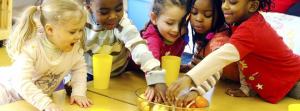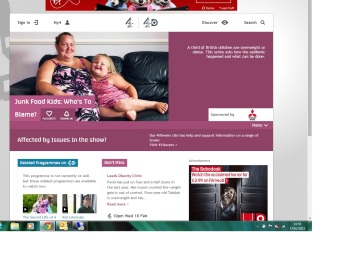 New research suggests the UK’s efforts to cut the amount of salt we eat have taken a backward slide in recent years. Here our Head of Nutrition, Dr Tricia Mucavele, blogs about why we’ve got to stop children getting a taste for salt before it even gets started.
New research suggests the UK’s efforts to cut the amount of salt we eat have taken a backward slide in recent years. Here our Head of Nutrition, Dr Tricia Mucavele, blogs about why we’ve got to stop children getting a taste for salt before it even gets started.
It’s simple; liking salt and salty foods is a learned taste – shaped by the food children are exposed to. The less salt children eat, the less they want. So, how can we limit children’s intake of salt? One way is to provide guidelines or standards for educational settings, as they can have a powerful influence on children’s eating habits.
Until three years ago there was no nationally recognised guidance on how to provide healthy, balanced and nutritious food in early years settings in England. We  worked with partners including nurseries, childminders and children’s centres to develop guidelines which are now recommended as best practice. This guidance and the practical tools including seasonal menus and recipes, have now been downloaded more than 20,000 times, we’ve trained more than 1,500 early years practitioners across 38 local authorities (a quarter of the country) and childcare teams as part of our Eat Better, Start Better programme. And we’re thrilled that early evaluation has shown changes in practices which will help limit the amount of salt provided by early years settings.
worked with partners including nurseries, childminders and children’s centres to develop guidelines which are now recommended as best practice. This guidance and the practical tools including seasonal menus and recipes, have now been downloaded more than 20,000 times, we’ve trained more than 1,500 early years practitioners across 38 local authorities (a quarter of the country) and childcare teams as part of our Eat Better, Start Better programme. And we’re thrilled that early evaluation has shown changes in practices which will help limit the amount of salt provided by early years settings.
The challenge now is how to spread this work even further: the guidelines are voluntary and providing early years providers with training relies on funding from local authorities and community organisations, who are themselves under funding pressures too.
For older children, we have mandatory school food standards in England. They specifically limit the amount of salt provided in school food by restricting foods high in salt such as condiments, meat products, battered and breadcrumb coated products, and not permitting salty snacks, or salt to be provided on the table.
Another part of the school food circle – the procurement of food – also plays a part in cutting salt for children. The new school food standards include the recommendation that schools use the Government Buying Standards nutrition criteria to choose their products and suppliers, to make sure they’re purchasing the healthiest (lowest in salt, fat, saturated fat, and sugar ) food and ingredients for children’s nutrition. The vast majority of these standards focus on reducing salt in ingredients and products. If we can encourage more schools and their caterers to use Government Buying Standards alongside the school food standards, we’ll bring down salt levels in school food even further.
I think with parent power behind us on cutting salt wherever children eat; we can really start to make a difference. Of course this includes salt in food when children eat out – a real challenge for parents.
What I think I’ve learned from my work for the Trust helping different businesses improve the food they provide for children is that there is a real will to deliver what customers want on this. And the more restaurants and retailers understand of parents’ concern for what their children’s options are on the menu, and of their demand for healthier options, the more change we’ll see. And it is possible. We’ve already worked with restaurants who’ve made great changes to get more fruit and veg into their children’s menu and to reduce the amount of fat and sugar. Just as schools are using all kinds of fabulous tricks and techniques to create lower-salt versions of favourite dishes, so can restaurants still have delicious food which feels like a treat but doesn’t mean children consume an entire day’s worth of salt in one sitting.
And finally, before I get off my salt box. Here are our three tips to reduce salt:
- Taste before you shake! Even better, why not urge the restaurants you go to to follow the guidelines for early years and the national standards for school food and simply remove salt from the table?
- Go for green! choose products with a green colour code for salt.
- Cook from scratch! Let’s Get Britain Cooking again – using fresh rather than pre-prepared foods.





 Less than two weeks to go. The manifestos have been scrutinised; the TV debates have been fascinating. The NHS is, of course, one of the key battleground issues that will help to shape how our next parliament looks. So why, then, is there one topic on which this election is worryingly quiet?
Less than two weeks to go. The manifestos have been scrutinised; the TV debates have been fascinating. The NHS is, of course, one of the key battleground issues that will help to shape how our next parliament looks. So why, then, is there one topic on which this election is worryingly quiet?










